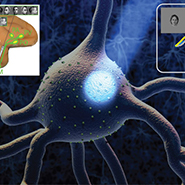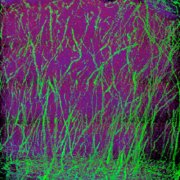The circuits that generate intelligent behaviors are large, 3-D structures that operate with millisecond timescale precision and are organized at the nanoscale. We are working on new technologies, including novel methods of super-resolution light microscopy that can image large 3-D structures with nanoscale precision, novel methods of fast imaging of neural dynamics in the living brain, novel microfabricated electrode arrays that can record electrical activity of many neurons at once in the living mammalian and perhaps even human brain, and new ways to activate and silence the activity of neurons throughout neural networks with pulses of light. By mapping brain circuits with molecular precision, recording the dynamics within brain circuits, and controlling the dynamics, we aim to examine how neurons in brain networks work together to generate the computations that support intelligent behavior, in species including mice, non-human primates, and humans, throughout the CBMM network.
Neural Circuits for Intelligence
 Abstract thinking and complex problem solving constitute paradigmatic examples of computation emerging from interconnected neuronal circuits. The biological hardware represents the output of millions of years of evolution leading to neuronal circuits that provide fast, efficient, and fault-tolerant solutions to complex problems. Progress toward a quantitative understanding of emergent intelligent computations in cortical circuits faces several empirical challenges (e.g., simultaneous recording and analysis of large ensembles of neurons and their interactions), and theoretical challenges (e.g., mathematical synthesis and modeling of the neuronal ensemble activity). Our team of theoreticians and neurophysiologists is focused on systematic, novel, and integrative approaches to deciphering the neuronal circuits underlying intelligence. Understanding neuronal circuits that implement solutions to complex challenges is an essential part of scientific reductionism, leading to insights useful for developing intelligent machines.
Abstract thinking and complex problem solving constitute paradigmatic examples of computation emerging from interconnected neuronal circuits. The biological hardware represents the output of millions of years of evolution leading to neuronal circuits that provide fast, efficient, and fault-tolerant solutions to complex problems. Progress toward a quantitative understanding of emergent intelligent computations in cortical circuits faces several empirical challenges (e.g., simultaneous recording and analysis of large ensembles of neurons and their interactions), and theoretical challenges (e.g., mathematical synthesis and modeling of the neuronal ensemble activity). Our team of theoreticians and neurophysiologists is focused on systematic, novel, and integrative approaches to deciphering the neuronal circuits underlying intelligence. Understanding neuronal circuits that implement solutions to complex challenges is an essential part of scientific reductionism, leading to insights useful for developing intelligent machines.

